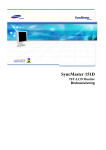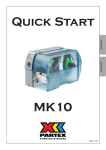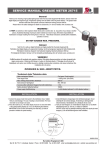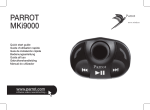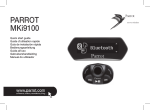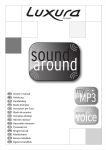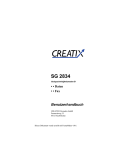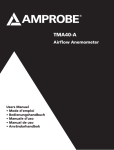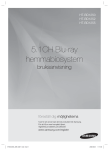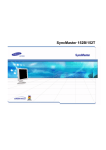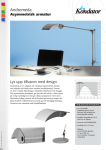Download TD-32 B - Delta Elektronik
Transcript
Galvanic Isolation Transient Protection Balanced Transmission CE Approved Appendix till installationsmanual 6178-2103 Appendix to installation manual 6178-2203 Anhang zur Bedienungsanleitung 6178-2303 Annexe au manuel d’installation 6178-2491 www.westermo.se © Westermo Teleindustri AB • 2001 • REV. A B 2 3 D T Introduktion TD-32 B är en ersättare till den ”gamla” TD-32. Det finns dock vissa små skillnader melllan de båda produkterna som är beskrivna i detta dokument. Installationsmanualen (6178-2103) är giltig förutom de undantag som står i detta appendix. TD-32 B är Europa godkänd och kan således användas i hela Europa. Lands specifika varianter av TD-32 B existerar inte. Specifikationer TD-32 B har samma specifikationer som TD-32 EU. Tabell över kommandon och S-register vars funktion skiljer sig från vad manualen beskriver. För en mer detaljerad beskrivning av skillnaderna, se beskrivningarna nedan. Kommandon i TD-32 %Dn \Gn \Ln Yn \F Nn \S &Bn &Kn &Tn ATI2 ATI3 ATI5 ATI6 ATI7 ATI9 S-18 S-19 S-20 S-24 S-32 S-33 S-37 S-39 S-82 2 Sida i manualen 6178-2103 (SE) 19 21 24 33 21 25 29 16 22 30 22 22 22 22 22 22 38 38 38 40 42 42 42 43 44 Beskrivning Inställning av mottagarns känslighet Flödeskontroll mellan modem MNP block eller teckenström Lång ”space” nedkoppling Visa lagrade nummer Automatmod Visa aktiv konfigurering Uppringning på DTR Flödeskontroll Test och kontroll Identifikationsrapport Identifikationsrapport Identifikationsrapport Identifikationsrapport Identifikationsrapport Identifikationsrapport Testtimer Autosync parametrar Autosync HDLC adress eller Sync Mottagarens nedkopplingsnivå XON tecken XOFF tecken Bit mappat register Bit mappat register Break kontroll för LAPM anslutningar Appendix till installationsmanual 6178-2103 AT –kommandon Skillnaderna bland AT-kommandon kan delas in i fem grupper: • Kommandon som existerar i TD-32 men inte i TD-32 B. • Kommandon som existerar i TD-32 men inte i TD-32 B men som har ett liknande kommando i TD-32 B med samma funktonalitet. • Kommandon som existerar både i varianterna men som har annorlunda funktonalitet i TD-32 B. • Kommandon som existerar både i varianterna men som har annorlunda resultatkoder i TD-32 B. • Nya kommandon i TD32 B som inte finns med i TD-32. Kommandon som existerar i TD-32 men inte i TD-32 B Kommando i TD-32: %Dn (n=0,1) Relevant kommando i TD-32 B: Inget Beskrivning: Ställer in minsta mottagen signal nivå innan nedkoppling. Default värdet är –43 dBm. Värdet sparas i S-register 24 (se S24 nedan). Nedkopplingsnivån kan inte ställas in i TD-32 B. Används aldrig eller väldigt sällan. Kommando i TD-32: \Gn (n=0,1) Relevant kommando i TD-32 B: Inget Beskrivning: Flödeskontroll mellan modem. Används endast i icke felkorrigerande moder. Används aldrig eller väldigt sällan. Kommando i TD-32: \Ln (n=0,1) Relevant kommando i TD-32 B: Inget Beskrivning: MNP block eller teckenström. Kontrollerar om MNP protokollet skall använda block eller teckenström överföring vid uppkoppling. Teckenström överföring är grundvärdet vid MNP uppkoppling. Används aldrig eller väldigt sällan. Kommando i TD-32: Yn (n=0,1) Relevant kommando i TD-32 B: Inget Beskrivning: Lång ”space” nedkoppling. Vid grundinställning är funktionen avstängd. Används aldrig eller väldigt sällan. Appendix till installationsmanual 6178-2103 3 Kommandon som existerar i TD-32. TD-32 B har ett liknande kommando med samma funktionalitet. Kommando i TD-32: \F Relevant kommando i TD-32 B: &V0 Beskrivning: Visar lagrade telefonnummer som har sparats med kommandot AT&Zn. Detta kommando fungerade inte tillfredställande i TD-32. I stället för detta kommando kan man använda AT&V0 för att se de telefonnummer som är sparade med AT&Zn. Kommando i TD-32: Nn (n=0,1) Relevant kommando i TD-32 B: AT+MS Beskrivning: Detta kommando (ATNn) väljer om modemet skall använda sig av fast eller automatisk linjehastighet vid ett uppkopplingsförsök. I TD-32 B får man samma funktionalitet med parameter två i kommandot AT+MS. Se också beskrivningen för ATNn i under nästa rubrik. Kommando i TD-32: \S Relevant kommando i TD-32 B: &V0 Beskrivning: Kommandot AT\S visar aktiv konfiguration med ett användarvänligt interface. I TD-32 B kan man se aktiv konfiguration med kommadot AT&V0. Detta kommando är inte lika användarvänligt som AT\S men visar samma information Kommando i TD-32: AT*NCK Relevant kommando i TD-32 B: AT+GCI Beskrivning: Ändrar landskod. Detta kommando är inte ett officiellt kommando som står beskrivet i manualen men det tas upp här eftersom det är frekvent använt. I TD-32 B är det inte relevant eftersom det bara finns en landsinställning: FD (EU-TBR) 4 Appendix till installationsmanual 6178-2103 Kommandon som existerar både i varianterna men som har annorlunda funktionalitet i TD-32 B Kommando i TD-32: &Bn (n=0,1) Relevant kommando i TD-32 B: &Bn (n=0,1) Beskrivning: Detta kommando tillåter att man kan använda sig av DTR-signalen för att göra en uppringning. Men om man använder sig av AT&D3 i kombination med kommandot för DTR uppringning så återstartar inte TD-32 B vid en negativ flank på DTR signalen (se ATZ – mjuk reset) utan lägger bara på. TD-32 lägger både på och återstartar vid samma förfarande Kommando i TD-32: &Kn (n=0,3,4,5,6) Relevant kommando i TD-32 B: &Kn (n=0,3,4,5) Beskrivning: Detta kommando ställer in önskad flödeskontroll. Det enda som skiljer modemen åt är att i TD-32 kan man ställa in AT&K6 (använd både XON/XOFF och RTS/CTS). I TD-32 B existerar inte alternativet AT&K6. Alla andra inställningar med kommadot AT&Kn fungerar likadant. AT&K6 kommandot används aldrig eller väldigt sällan. Kommando i TD-32: ATNn (n=0,1) Relevant kommando i TD-32 B: ATNn (n=1) Beskrivning: Detta kommando (ATNn) väljer om modemet skall använda sig av fast eller automatisk linjehastighet vid ett uppkopplingsförsök i TD-32. I TD-32 B är kommandot bara implementerat för kompatibilitets skäl och då är bara ATN1 tillåtet. För att ställa in automod i TD-32 B ska man använda sig av kommandot AT+MS. Kommando i TD-32: &Tn (n=0,1,2,3,4,5,6,7 and 8) Relevant kommando i TD-32 B: &Tn (n=0,1) Beskrivning: Detta kommando genomför olika tester enligt V.54 loop 2 och loop 3. Loop 2 kan antingen vara en lokal eller en remote digital återkopplings test och loop 3 kan antingen vara en lokal eller en remote analog återkopplings test. I TD-32 är loop 2 och loop 3 samt några variationer implementerade. I TD-32 B är bara loop 3 med analog återkoppling implementerad. Dessa test kommandon används aldrig eller väldigt sällan. Appendix till installationsmanual 6178-2103 5 Kommandon som existerar både i varianterna men som har annorlunda resultatkoder i TD-32 B. Kommando I TD-32 I TD-32 B Note. ATI2 <CR><LF> OK <CR><LF> <CR><LF> OK <CR><LF> <CR><LF> OK <CR><LF> ATI3 <CR><LF> V2.400A<CR><LF> <CR><LF> OK <CR><LF> <CR><LF> V3.500-V90_2M_DLS <CR><LF> <CR><LF> OK <CR><LF> ATI5 <CR><LF> 49 <CR><LF> <CR><LF> OK <CR><LF> <CR><LF> FD <CR><LF> <CR><LF> OK <CR><LF> ATI6 <CR><LF> RCV144Dpi Rev CA <CR><LF> <CR><LF> OK <CR><LF> <CR><LF> RCV336DPF-PLL L8571A Rev 43.06/43.06 <CR><LF> <CR><LF> OK <CR><LF> ATI7 <CR><LF> 000 <CR><LF> <CR><LF> OK <CR><LF> <CR><LF> OK <CR><LF> ATI9 <CR><LF> <CR><LF> ” firmware build time stamp” <CR><LF> <CR><LF> OK <CR><LF> <CR><LF> <CR><LF> ”firmware revision” <CR><LF> OK <CR><LF> (se nedan) Nya kommadon i TD-32 B som inte finns med i TD-32 Kommando i TD-32: None Relevant kommando i TD-32 B: +MS Beskrivning: Detta kommando kontrollerar vilken modulation modemet skall använda sig av vid en uppkoppling. För att se vilka alternativa parametrar man kan använda sig av kan man ange ”=?” efter kommandot (AT+MS=?) och för att se det aktiva värde som kommandot har kan man ange ”?” efter kommandot (AT+MS?). 6 Appendix till installationsmanual 6178-2103 S-register S-register: Beskrivning TD-32: Beskrivning TD-32 B: S-18 Används som test timer för test kommandona AT&Tn. Används inte. Test kommandona i TD-32 B avbryts med escape sekvens (+++). Returnerar 000 vid förfrågan om värde. S-register: Beskrivning TD-32: Beskrivning TD-32 B: S-19 Autosync parametrar – ej ändringsbart för användaren. Används för bakåt kompatibilitet. Inget värde kan skrivas till registret, Returnerar 000 vid förfrågan om värde. S-register: Beskrivning TD-32: Beskrivning TD-32 B: S-20 Autosynk HDLC adress/BSC synk – ej ändringsbart för användaren. Används för bakåt kompatibilitet. Inget värde kan skrivas till registret, Returnerar 000 vid förfrågan om värde. S-register: Beskrivning TD-32: Beskrivning TD-32 B: S-24 Används för mottagarens nedkopplingsnivå om kommandot AT%D1 är satt. Används som ”Sleep inactivity timer”. Om registret är satt till något annat än 0 och modemet befinner sig i normal mod, väntar modemet i det antal sekunder som är specificerat med S24 innan modemet går över till ”Sleep mode”. Grundvärdet är 000. S-register: Beskrivning TD-32: Beskrivning TD-32 B: S-32 XON tecken. Grundvärde: 1710 Används inte. Returnerar 000 vid förfrågan om värde. S-register: Beskrivning TD-32: Beskrivning TD-32 B: S-33 XOFF tecken. Grundvärde: 1910 Används inte. Returnerar 000 vid förfrågan om värde. S-register: Beskrivning TD-32: S-37 Önskad linjehastighet. Motsvarar det värde som man ger tillsammans med kommandot ATFn Används inte. Returnerar 000 vid förfrågan om värde. Beskrivning TD-32 B: S-register: Beskrivning TD-32: Beskrivning TD-32 B: S-39 Flödeskontroll, bit mappat register bit 0-2. Accepterar värdena 0, 3, 4, 5 och 6. Flödeskontroll, bit mappat register bit 0-2. Accepterar värdena 0, 3, 4 och 5. Värdet 6 accepteras ej. S-register: S-82 Beskrivning TD-32: Beskrivning TD-32 B: Break kontroll för LAPM anslutningar. Används inte. Returnerar 000 vid förfrågan om värde. S-register: S-210 Beskrivning TD-32: Beskrivning TD-32 B: Används inte. Returnerar ERROR vid förfrågan om värde. Ställer in området för tillåtet V.34 symbol hastigheter. Kontrollerar asymmetriska hastigheter. Appendix till installationsmanual 6178-2103 7 Introduction The TD-32 B is a replacement for the “old” TD-32. However, some minor changes are identified and described in this document.. The original installation manual (6178-2203) is valid except for the differences described in this appendix. The TD-32 B has no country specific models, only a pan-European approved version. Specifications The TD-32 B has the same specifications as the TD-32 EU. Short form table of commands and s-registers that differs in any way. For a more detailed description of what differs see the long form description below. Commands in TD-32 %Dn \Gn \Ln Yn \F Nn \S &Bn &Kn &Tn ATI2 ATI3 ATI5 ATI6 ATI7 ATI9 S-18 S-19 S-20 S-24 S-32 S-33 S-37 S-39 S-82 8 Page in manual 6178-2203 (ENG) 19 21 24 33 21 25 29 16 22 30 22 22 22 22 22 22 38 38 38 40 42 42 42 43 44 Description Setting the sensitivity of receiver Modem-to-modem flow control MNP block or stream mode Long space disconnect Display stored numbers Automode Report active configuration DTR dial option Flow control Test and diagnostics Identification report Identification report Identification report Identification report Identification report Identification report Test timer Autosync bit mapped options Autosync HDLC address or Sync character Receiver disconnect level XON character XOFF character Bit mapped register Bit mapped register Break control for LAPM connections Appendix to installation manual 6178-2203 AT –commands The differences in command mode can be divided in four groups: • Commands that exists in the TD-32 but do not exist in the TD-32 B • Commands that exists in the TD-32 but not in the TD-32 B but have a similar command in the TD-32 B with the same functionality • Commands that exists in both the TD-32 and the TD-32 B but have a different functionality in the TD-32 B. • Commands that exists in both the TD-32 and the TD-32 B but have different result codes in the TD-32 B • New commands in the TD-32 B that do not exist in the TD-32 Commands that exists in the TD-32 but do not exist in the TD32 B. Command in TD-32: %Dn (n=0,1) Relevant command in TD-32 B: None Description: Sets the minimum level of received signal before disconnection. The default value is -43 dBm). The value is stored in S-register 24 (see S24 below). The disconnect level can not be set in TD-32 B. Never or extremely rarely used. Command in TD-32: Relevant command in TD-32 B: Description: \Gn (n=0,1) None Modem to modem flow control. Only valid non-error correction modes. Never or extremely rarely used. Command in TD-32: Relevant command in TD-32 B: Description: \Ln (n=0,1) None MNP block or stream mode select. At connection time this command controls the selection between block and stream mode in MNP connections. Default is stream mode for MNP connections. Never or extremely rarely used. Command in TD-32: Relevant command in TD-32 B: Description: Yn (n=0,1) None Long space disconnect. Default is disabled. Never or extremely rarely used. Appendix to installation manual 6178-2203 9 Commands only in the TD-32. TD-32 B have similar commands with the same functionality. Command in TD-32: \F Relevant command in TD-32 B: &V0 Description: Display telephone directory entries saved by AT&Zn. This command didn’t work in the TD-32. Instead of this command one can use the AT&V0 to see the saved telephone numbers. Command in TD-32: Relevant command in TD-32 B: Description: Nn (n=0,1) AT+MS The ATNn command in the TD-32 enables/disables automode detection. The same functionality can be found in the second parameter of the AT+MS command in the TD-32 B. See also the ATNn command in the next section. Command in TD-32: Relevant command in TD-32 B: Description: \S &V0 The \S command in the TD-32 displays current modem settings in a user friendly interface. The current settings can be viewed with the command AT&V0. This command is not as user friendly as the AT\S but still all information needed can be found. Command in TD-32: Relevant command in TD-32 B: Description: AT*NCK AT+GCI Change country code. This is not an official command described in the manual. It has no relevance since only country code supported in TD32 B is FD (EU-TBR). 10 Appendix to installation manual 6178-2203 Commands present in the TD-32 and in the TD-32 B but with different functionality. Command in TD-32: Relevant command in TD-32 B: Description: &Bn (n=0,1) &Bn (n=0,1) Enables DTR dialing but when AT&D3 is used together with &B1, the TD-32 B does not restart as described under the AT&D3 command in the TD32 manual, it just goes on hook. Command in TD-32: Relevant command in TD-32 B: Description: &Kn (n=0,3,4,5,6) &Kn (n=0,3,4,5) Command to set the DTE flow control. The only thing that is different in the TD-32 B is the AT&K6 commmand option which means that both XON/XOFF and RTS/CTS flow control is used. All other options in this command are the same. This command option is never or extremely rarely used. Command in TD-32: Relevant command in TD-32 B: Description: ATNn (n=0,1) ATNn (n=1) Enables/disables automode detection in TD-32. In TD32 B it is only implemented for compatibility reasons and only ATN1 is valid. In TD-32 B, use the automode settings implemented with AT+MS instead. Command in TD-32: Relevant command in TD-32 B: Description: &Tn (n=0,1,2,3,4,5,6,7 and 8) &Tn (n=0,1) Test commands according to V.54 loop 2 and loop 3. Loop 2 is either a local or remote digital loopback test and loop 3 is either a local or remote analogue loopback test. In the TD-32, loop 2, loop 3 and some variations of the two loops are implemented. In TD-32 B only loop 3 local analogue loopback test is implemented. The test commands are never or extremely rarely used. Appendix to installation manual 6178-2203 11 Commands in both the TD-32 and the TD-32 B but with different result codes Command In TD-32 In TD-32 B Note. ATI2 <CR><LF> OK <CR><LF> <CR><LF> OK <CR><LF> <CR><LF> OK <CR><LF> ATI3 <CR><LF> V2.400A<CR><LF> <CR><LF> OK <CR><LF> <CR><LF> V3.500-V90_2M_DLS <CR><LF> <CR><LF> OK <CR><LF> ATI5 <CR><LF> 49 <CR><LF> <CR><LF> OK <CR><LF> <CR><LF> FD <CR><LF> <CR><LF> OK <CR><LF> ATI6 <CR><LF> RCV144Dpi Rev CA <CR><LF> <CR><LF> OK <CR><LF> <CR><LF> RCV336DPF-PLL L8571A Rev 43.06/43.06 <CR><LF> <CR><LF> OK <CR><LF> ATI7 <CR><LF> 000 <CR><LF> <CR><LF> OK <CR><LF> <CR><LF> OK <CR><LF> ATI9 <CR><LF> <CR><LF> ” firmware build time stamp” <CR><LF> <CR><LF> OK <CR><LF> <CR><LF> <CR><LF> ”firmware revision” <CR><LF> OK <CR><LF> (see below) New commands in the TD-32 B that do not exist in the TD-32 Command in TD-32: Relevant command in TD-32 B: Description: 12 None +MS This command controls the modulation technique used in a connection. To display the valid parameters enter the command AT+MS=?. And to see the active setting of the command enter AT+MS? Appendix to installation manual 6178-2203 S-registers S-register: Description TD-32: Description TD-32 B: S-18 Used as a timer for the test commands &Tn. Not used. The test commands in TD-32 B is terminated via the escape sequence. Returns 000 when accessed. S-register: Description TD-32: Description TD-32 B: S-19 Autosync bitmapped options – not editable by user. For backwards compatibility only. No value can be written. Returns 000 when accessed. S-register: Description TD-32: Description TD-32 B: S-20 Autosync HDLC address or BSC sync character – not editable by user. For backwards compatibility only. No value can be written. Returns 000 when accessed. S-register: Description TD-32: S-24 Used to hold the value of the lowest acceptable received line signal when using the %D1 command. Used as the Sleep Inactivity timer. When in normal mode of the TD-32 B the modem waits the number of seconds specified by this register before it enter sleep mode. Description TD-32 B: S-register: Description TD-32: Description TD-32 B: S-32 XON character. Default: 1710 Not used. Returns 000 when accessed. S-register: Description TD-32: Description TD-32 B: S-33 XOFF character. Default 1910 Not used. Returns 000 when accessed. S-register: Description TD-32: S-37 Desired line connection speed. Corresponds to the value given by the command ATFn. Not used. Returns 000 when accessed. Description TD-32 B: S-register: Description TD-32: Description TD-32 B: S-39 Flow control bit mapped options status bit 0-2. Values 0,3, 4,5 and 6 is accepted. The value 6 indicates that both methods are used. Flow control bit mapped options status bit 0-2. Values 0, 3, 4 and 5 is accepted. Value 6 is not supported. S-register: S-82 Description TD-32: Description TD-32 B: Break control for LAPM connections. Not used. Returns 000 when accessed. S-register: S-210 Description TD-32: Description TD-32 B: Not used. Returns ERROR when accessed. Sets the range of V.34 symbol rates. Enables/disables asymmetric rates. Appendix to installation manual 6178-2203 13 Einleitung Das TD-32 B ist ein ersatz für das “alte” TD-32. Dadurch haben sich kleine Änderungen ergeben, welche in diesem Dokument beschrieben sind. Die original Bedienungsanleitung (??6178-2203) gilt weiterhin, außer für die nachfolgend aufgeführten Punkte. Das TD-32 B ist nur als Europa Version erhältlich. Technische Daten Das TD-32 B besitzt die selben Eigenschaften wie das TD-32 EU. Kurzübersicht der geänderten Befehle und S-Register Eine ausführliche Beschreibung folgt in diesem Dokument. Befehl des TD-32 Seite in Anleitung 6178-2303 (DE) %Dn \Gn \Ln Yn \F Nn \S &Bn &Kn &Tn ATI2 ATI3 ATI5 ATI6 ATI7 ATI9 S-18 S-19 S-20 19 21 24 33 21 25 29 16 22 30 22 22 22 22 22 22 38 38 38 S-24 S-32 S-33 S-37 S-39 S-82 40 42 42 42 43 44 14 Beschreibung Empfindlichkeit des Empfängers Modem-zu-modem Datenflußsteuerung MNP Block oder Datenstron Modus Langes Space Anzeige gespeicherter Nummern Automode Anzeige der aktiven Konfiguration DTR Wähloption Datenflussteuerung Test und Diagnose Identifikations Anzeige Identifikations Anzeige Identifikations Anzeige Identifikations Anzeige Identifikations Anzeige Identifikations Anzeige Zeitgeber für Tests Automatisch Synchronisation Auto. Synchronisation HDLC Adresse oder sync. Zeichen Abbruchpegel für Empfang XON Zeichen XOFF Zeichen Bit mapped Register Bit mapped Register Breaksteuerung für LAPM Verbindungen Anhang zur Bedienungsanleitung 6178-2303 AT – Befehle Die Unterschiede im Befehlsmodus können in vier Gruppen aufgeteilt werden: • Befehle des TD-32 die nicht im TD-32 B enthalten sind • Befehle des TD-32 die nicht im TD-32 B enthalten sind, aber es gleiche Befehle im TD32 B mit der selben Funktionalität gibt • Befehle die im TD-32 und TD-32 B existieren, aber andere Funktionen aufweisen. • Befehle die im TD-32 und TD-32 B existieren, aber andere Ergebnisscodes liefern • Neue Befehle des TD-32 B die nicht im TD-32 enthalten sind Befehle des TD-32 die nicht im TD-32 B enthalten sind. Befehl des TD-32: %Dn (n=0,1) Befehl des TD-32 B: kein Beschreibung: Bestimmt den minimalen Empfangspegel, bevor die Verbindung unterbrochen wird (Werkseinstellung -43 dBm). Der Wert wird im S-Register 24 (siehe S24) gespeichert. Dieser Pegel kann im TD-32 B nicht gesetzt werden. Niemals oder nur sehr selten benutzt. Befehl des TD-32: Befehl des TD-32 B: Beschreibung: \Gn (n=0,1) kein Modem zu Modem Datenflussteuerung. Nur für Verbindungen ohne Fehlerkorrektur. Niemals oder nur sehr selten benutzt. Befehl des TD-32: Befehl des TD-32 B: Beschreibung: \Ln (n=0,1) kein MNP Block oder Datenstrom Modus. Beim Verbindungsaufbau setzt dieser Befehl ob Block oder Datenstrom Modus bei MNP Verbindungen benutzt wird. Werkseinstellung ist Datenstrom Modus bei MNP verbindungen. Niemals oder nur sehr selten benutzt. Befehl des TD-32: Befehl des TD-32 B: Beschreibung: Yn (n=0,1) kein Trennen bei langem Space Signal. Werkseinstellung deaktiviert. Niemals oder nur sehr selten benutzt. Anhang zur Bedienungsanleitung 6178-2303 15 Befehle des TD-32 die nicht im TD-32 B enthalten sind, aber es gleiche Befehle im TD-32 B mit der selben Funktionalität gibt Befehl des TD-32: \F Befehl des TD-32 B: &V0 Beschreibung: Anzeige der durch AT&Zn eingetragenen Telefonnummern. Dieser Befehl funktionierte nicht im TD-32. Anstatt dieses Befehls kann der AT&V0 eingesetzt werden. Befehl des TD-32: Befehl des TD-32 B: Beschreibung: Nn (n=0,1) AT+MS Der ATNn Befehl des TD-32 aktivierte/deaktivierte die Automode Erkennung. Dieselbe Funktionalität kann mit dem zweiten Parameter des AT+MS Befehls des TD-32 B erreicht werden. Siehe auch ATNn Befehl im nächsten Abschnitt. Befehl des TD-32: Befehl des TD-32 B: Beschreibung: \S &V0 Der \S Befehl des TD-32 zeigt die aktuelle Modemeinstellung benutzerfreundlich an. Die aktuelle Konfiguration kann mit AT&V0 angezeigt werden, ist aber nicht so benutzerfreundlich, enthält aber alle notwendigen Informationen. Befehl des TD-32: Befehl des TD-32 B: Beschreibung: AT*NCK AT+GCI Ändern der Landeseinstellung. Dies ist ein nicht in der Anleitung beschriebener Befehl. Nicht relevant, da nur Europa im TD32 B unterstützt wird (FD = EU-TBR). 16 Anhang zur Bedienungsanleitung 6178-2303 Befehle die im TD-32 und TD-32 B existieren, aber andere Funktionen aufweisen. Befehl des TD-32: Befehl des TD-32 B: Beschreibung: &Bn (n=0,1) &Bn (n=0,1) Aktiviert DTR Wahl, aber wenn AT&D3 und AT&B1 benutzt wird, so fährt das TD-32 B nicht reset, wie unter AT&D3 beschrieben, sondern legt nur auf. Befehl des TD-32: Befehl des TD-32 B: Beschreibung: &Kn (n=0,3,4,5,6) &Kn (n=0,3,4,5) Befehl zum setzen der Datenflussteuerung zur DEE. Der einzige Unterschied des TD-32 B ist die AT&K6 Option welche XON/XOFF und RTS/CTS Steuerung setzt. Alle anderen optionen sind gleich Die Option wird niemals oder nur sehr selten benutzt Befehl des TD-32: Befehl des TD-32 B: Beschreibung: ATNn (n=0,1) ATNn (n=1) Aktiviert/deaktiviert Automode Erkennung des TD-32. Wurde im TD-32 B nur zu kompatibilitäts Zwecken implementiert, nur ATN1 ist ein gültiger Parameter. Beim TD-32 B wird der Automode durch AT+MS gesetzt. Befehl des TD-32: Befehl des TD-32 B: Beschreibung: &Tn (n=0,1,2,3,4,5,6,7 and 8) &Tn (n=0,1) Test Befehle nach V.54 loop 2 und loop 3. Loop 2 ist entweder ein lokaler oder entfernter digitaler loopback Test und loop 3 ist entweder ein lokaler oder entfernter analoger loopback Test. Im TD-32 sind loop 2, loop 3 und weitere Variationen implementiert. Im TD-32 B wird nur loop 3, lokaler analoger loopback Test unterstützt. Wird niemals oder nur sehr selten benutzt. Anhang zur Bedienungsanleitung 6178-2303 17 Befehle die im TD-32 und TD-32 B existieren, aber andere Ergebnisscodes liefern Befehl Im TD-32 Im TD-32 B Hinweis ATI2 <CR><LF> OK <CR><LF> <CR><LF> OK <CR><LF> <CR><LF> OK <CR><LF> ATI3 <CR><LF> V2.400A<CR><LF> <CR><LF> OK <CR><LF> <CR><LF> V3.500-V90_2M_DLS <CR><LF> <CR><LF> OK <CR><LF> ATI5 <CR><LF> 49 <CR><LF> <CR><LF> OK <CR><LF> <CR><LF> FD <CR><LF> <CR><LF> OK <CR><LF> ATI6 <CR><LF> RCV144Dpi Rev CA <CR><LF> <CR><LF> OK <CR><LF> <CR><LF> RCV336DPF-PLL L8571A Rev 43.06/43.06 <CR><LF> <CR><LF> OK <CR><LF> ATI7 <CR><LF> 000 <CR><LF> <CR><LF> OK <CR><LF> <CR><LF> OK <CR><LF> ATI9 <CR><LF> <CR><LF> ” firmware build time stamp” <CR><LF> <CR><LF> OK <CR><LF> <CR><LF> <CR><LF> ”firmware revision” <CR><LF> OK <CR><LF> (siehe unten) Neue Befehle des TD-32 B die nicht im TD-32 enthalten sind Befehl des TD-32: Befehl des TD-32 B: Beschreibung: 18 kein +MS Dieser Befehl steuert die gewählte Modulationsart für diese Verbindung. Zur Anzeige der gültigen Parameter ist der Befehl AT+MS=? einzugeben. Um das aktive Profil zu lesen wird AT+MS? Benutzt. Anhang zur Bedienungsanleitung 6178-2303 S-Registers S-Register: Beschreibung TD-32: Beschreibung TD-32 B: S-18 Zeitgeber für die &Tn Testbefehle. Nicht benutzt. Die Testbefehle des TD-32 B werden durch die Escape Sequenz beendet. Gibt 000 zurück. S-Register: Beschreibung TD-32: Beschreibung TD-32 B: S-19 Autosync Bitmapped Option – nicht vom Anwender editierbar. Nur zu Kompatibilitätszwecken. Kein Wert kann geschrieben werden. Gibt 000 zurück. S-Register: Beschreibung TD-32: Beschreibung TD-32 B: S-20 Autosync HDLC Adresse oder BSC Sync Zeichen – nicht editierbar. Nur zu Kompatibilitätszwecken. Kein Wert kann geschrieben werden. Gibt 000 zurück. S-Register: Beschreibung TD-32: S-24 Wird benutzt, um den Wert des niedrigsten akzeptierbaren Empafangspegel zu setzen, wenn %D1 benutzt wird. Benutzt als Sleep Inactivity Timer. Bei Normalbetrieb des TD-32 B wartet das Modem die Anzahl der Sekunden, gesetzt durch dieses Register, ab bevor es in Sleep Mode geht. Beschreibung TD-32 B: S-Register: Beschreibung TD-32: Beschreibung TD-32 B: S-32 XON Zeichen. Werkseinstellung: 1710 Nicht benutzt. Gibt 000 zurück. S-Register: Beschreibung TD-32: Beschreibung TD-32 B: S-33 XOFF Zeichen. Werkseinstellung 1910 Nicht benutzt. Gibt 000 zurück. S-Register: Beschreibung TD-32: S-37 Verbindungsgeschwindigkeit auf der Leitung. Bezieht sich auf den mit ATFn gesetzten Wert. Nicht benutzt. Gibt 000 zurück. Beschreibung TD-32 B: S-Register: Beschreibung TD-32: Beschreibung TD-32 B: S-39 Datenflussteuerung Bit mapped Option Statusbit 0-2. Wert 0, 3, 4, 5 und 6 werden akzeptiert. Der Wert 6 zeight die Anwendung beider Optionen an. Flow control bit mapped options status bit 0-2. Values 0, 3, 4 and 5 is accepted. Value 6 is not supported. S-Register: S-82 Beschreibung TD-32: Beschreibung TD-32 B: Breaksteuerung bei LAPM Verbindungen Nicht benutzt. Gibt 000 zurück. S-Register: S-210 Beschreibung TD-32: Beschreibung TD-32 B: Nicht benutzt. Gibt ERROR zurück. Setzt die Grenzen der V.34 Übertragungsraten. Aktiviert/deaktiviert asymmetrische Datenraten. Anhang zur Bedienungsanleitung 6178-2303 19 Introduction Le TD-32 B est le remplaçant du TD-32 existant. Cependant certains changements ont été identifiés et sont décrits dans ce document. Le manuel d’installation d’origine (61782491) reste valable excepté les différences qui sont décrites dans cette annexe. Le TD-32 B n’existe pas en version personnalisée par pays. Seule une version pan-européenne est disponible. Spécifications Le TD-32 B possède les mêmes caractéristiques que le TD-32 EU. Tableau Résumant les commandes et registres S qui changent Pour obtenir une description détaillée ou connaître les changements correspondants, merci de se reporter au paragraphe qui suit le tableau. Commandes du TD-32 %Dn \Gn \Ln Yn \F Nn \S &Bn &Kn &Tn ATI2 ATI3 ATI5 ATI6 ATI7 ATI9 S-18 S-19 S-20 S-24 S-32 S-33 S-37 S-39 S-82 20 Page correspondante dans le manuel réf: 6178-2491 19 21 24 33 21 25 29 16 22 30 22 22 22 22 22 22 38 38 38 40 42 42 42 43 44 Description Configuration de la sensibilité du récepteur Contrôle de flux modem à modem Sélection du mode bloc ou mode stream MNP Déconnexion sur grand espace Affiche la liste des N° d’appels sauvegardés Mode Auto Affiche la configuration active Option numérotation par DTR Contrôle de flux Test et diagnostics Rapport d’identification Rapport d’identification Rapport d’identification Rapport d’identification Rapport d’identification Rapport d’identification Test timer Organisation du bit AutoSync Adresse caractère AutoSync HDLC ou SYNC Niveau de déconnexion récepteur Caractère XON Caractère XOFF Organisation des bits du registre Organisation des bits du registre Contrôle Break pour connexion LAPM Annexe au manuel d’installation 6178-2491 Commandes AT Les changements concernant les différentes commandes sont répartis en quatre groupes : • Commandes existantes dans le TD-32 mais qui n’existent plus dans le TD-32 B • Commandes existantes dans le TD-32 et qui ont disparu dans le TD-32 B mais qui sont remplacées par d’autres commandes similaires avec les mêmes fonctionnalités. • Commandes existantes dans le TD-32 et TD-32 B mais avec des fonctions différentes dans le TD-32 B • Commandes existantes dans le TD-32 et TD-32 B mais avec des codes de résultats différents dans le TD-32 B • Nouvelles commandes dans le TD-32 B et qui n’existent pas dans le TD-32. Commandes existantes dans le TD-32 et qui n’existent pas dans le TD-32 B. Commande dans TD-32 : %Dn (n=0,1) Commande similaire dans TD-32 B : Aucune Description : Définit la déconnexion du modem lorsque le niveau du signal de réception est inférieur au seuil nominal (Valeur par défaut : -43dBm). La valeur est stockée dans le registre S-24.(voir S-24 ci-dessous). Le niveau de déconnexion n’est pas configurable dans le TD-32 B. Jamais ou rarement utilisé. Commande dans TD-32 : \Gn (n=0,1) Commande similaire dans TD-32 B : Aucune Description : Contrôle de flux modem à modem. Uniquement actif en mode de correction sans erreur. Jamais ou rarement utilisé. Commande dans TD-32 : \Ln (n=0,1) Commande similaire dans TD-32 B : Aucune Description : Sélection du mode bloc MNP ou mode stream. Au moment de la connexion, cette commande contrôle la sélection entre le mode block et le mode stream dans les connexions MNP. Par défaut, le mode stream est activé pour les connexions MNP. Jamais ou rarement utilisé. Commande dans TD-32 : Yn (n=0,1) Commande similaire dans TD-32 B : Aucune Description : Déconnexion sur grand espace. Désactivé par défaut. Jamais ou rarement utilisé. Annexe au manuel d’installation 6178-2491 21 Commandes existantes uniquement dans le TD-32. Le TD-32 B possède des commandes similaires avec la même fonction. Commande dans TD-32 : \F Commande similaire dans TD-32 B : &V0 Description : Affiche la liste des N° d’appel sauvegardés avec la commande AT&Zn. Cette commande ne fonctionne pas sur le TD-32. On peut utiliser en lieu et place la commande AT&V0 pour voir la liste des N° d’appel sauvegardés. Commande dans TD-32 : Nn (n=0,1) Commande similaire dans TD-32 B : AT+MS Description : La commande ATNn active ou désactive la détection du mode auto dans le TD-32. La même fonction existe dans le second paramètre de la commmande AT+MS dans le TD-32 B. Se reporter à la commande ATNn du prochain paragraphe. Commande dans TD-32 : \S Commande similaire dans TD-32 B : &V0 Description : La commande \S du TD-32, affiche les paramètres de la configuration active du modem sous forme d’un tableau convivial. Dans le TD-32 B la configuration active est affichée avec la commande AT&V0 sous une forme moins détaillée mais dans laquelle toutes les informations nécessaire sont disponibles. Commande dans TD-32 : AT*NCK Commande similaire dans TD-32 B : AT+GCI Description : Permet de changer le code du pays. Cette commmande non officielle n’est pas décrite dans le manuel. Elle n’a plus de rapport puisque le seul code du pays supporté dans le TD-32 B est FD (EU-TBR). 22 Annexe au manuel d’installation 6178-2491 Commandes existantes dans le TD-32 et le TD-32 B mais avec des fonctions différentes. Commande dans TD-32 : &Bn (n=0,1) Commande similaire dans TD-32 B : &Bn (n=0,1) Description : Active la numérotation par DTR mais lorsque AT&D3 est utilisé conjointement avec &B1. Le TD-32 B ne se réinitialise pas avec AT&D3 comme il est décrit dans le manuel du TD-32. Il raccroche simplement. Commande dans TD-32 : &Kn (n=0,3,4,5,6) Commande similaire dans TD-32 B : &Kn (n=0,3,4,5) Description : Cette commande configure le contrôle de flux DTE. La seule différence avec le TD-32 B concerne L’option AT&K6 (active ensemble le contrôle de flux XON/XOFF et RTS/CTS). Toutes les autres options sont identiques. Cette option de commande n’est jamais ou rarement utilisée. Commande dans TD-32 : ATNn (n=0,1) Commande similaire dans TD-32 B : ATNn (n=1) Description : Active ou désactive la détection du mode auto dans le TD-32. Dans le TD-32 B, cette commande n’existe que pour des raisons de compatibilité et seul ATN1 est valide. La configuration du mode auto dans le TD-32 B est configurable avec la commande AT+MS. Commande dans TD-32 : &Tn (n=0,1,2,3,4,5,6,7 and 8) Commande similaire dans TD-32 B : &Tn (n=0,1) Description : Commande de test V.54 boucle 2 et boucle 3. La boucle 2 peut être un test de bouclage digital local ou distant et la boucle 3 fait de même mais pour un test en analogique.Dans le TD-32, la boucle 2,boucle 3 et certaines variations des 2 boucles sont implémentées. Dans le TD-32 B seule la boucle 3, bouclage analogique local, est supportée. Les commandes de test ne sont jamais ou rarement utilisées. Annexe au manuel d’installation 6178-2491 23 Commandes communes aux TD-32 et TD-32 B mais avec des codes de résultats différents. Commandes Dans TD-32 Dans TD-32 B Remarque ATI2 <CR><LF> OK <CR><LF> <CR><LF> OK <CR><LF> <CR><LF> OK <CR><LF> ATI3 <CR><LF> V2.400A<CR><LF> <CR><LF> OK <CR><LF> <CR><LF> V3.500-V90_2M_DLS <CR><LF> <CR><LF> OK <CR><LF> ATI5 <CR><LF> 49 <CR><LF> <CR><LF> OK <CR><LF> <CR><LF> FD <CR><LF> <CR><LF> OK <CR><LF> ATI6 <CR><LF> RCV144Dpi Rev CA <CR><LF> <CR><LF> OK <CR><LF> <CR><LF> RCV336DPF-PLL L8571A Rev 43.06/43.06 <CR><LF> <CR><LF> OK <CR><LF> ATI7 <CR><LF> 000 <CR><LF> <CR><LF> OK <CR><LF> <CR><LF> OK <CR><LF> ATI9 <CR><LF> <CR><LF> “Horodatage du Firmware” <CR><LF> <CR><LF> OK <CR><LF> <CR><LF> <CR><LF> “Révision du firmware” <CR><LF> OK <CR><LF> (voir cidessous) Nouvelles commandes du TD-32 B qui n’existent pas dans le TD-32 Commande dans TD-32 : Aucune Commande similaire dans TD-32 B : +MS Description : Cette commande contrôle la technique de modulation utilisée dans la connexion. Pour afficher le détail des paramètres, taper la commande AT+MS= ? et pour afficher les paramètres en cours, taper AT+MS ? 24 Annexe au manuel d’installation 6178-2491 Registres S Registre S : Description TD-32 : Description TD-32 B : S-18 Utilisé comme timer pour les commandes de test et &Tn. Non utilisé. Les commandes de test dans le TD-32 B sont achevées par la séquence escape. Renvoie 000 à toute demande d’accès . Registre S : Description TD-32 : Description TD-32 B : S-19 Organisation bit autosync. Non visible par l’utilisateur. Uniquement pour les compatibilités d’arrière plan. Aucune valeur n’est inscrite. Renvoie 000 à toute demande d’accès. Registre S : Description TD-32 : S-20 Adresse HDLC autosync ou caractère de sync.BSC. Non visible par l’utilisateur. Uniquement pour les compatibilités d’arrière plan. Aucune valeur n’est inscrite. Renvoie 000 à toute demande d’accès. Description TD-32 B : Registre S : Description TD-32 : Description TD-32 B : S-24 Utilisé pour stocker la plus faible valeur acceptable du signal de réception ligne lorsque l’on utilise la commande %D1. Utilisé comme timer de mise en veille d’inactivité. Quand le TD-32 B est en mode normal, le modem attend durant la période en seconde spécifiée dans ce registre avant de passer en mode veille. Registre S : Description TD-32 : Description TD-32 B : S-32 Caractère XON. Par défaut : 1710 Non utilisé, renvoie 000 à toute demande d’accès. Registre S : Description TD-32 : Description TD-32 B : S-33 Caractère XOFF. Par défaut : 1910 Non utilisé, renvoie 000 à toute demande d’accès. Registre S : Description TD-32 : S-37 Vitesse de connexion souhaitée. Correspond à la valeur fournie par la commande ATFn. Non utilisé, renvoie 000 à toute demande d’accès. Description TD-32 B : Registre S : Description TD-32 : Description TD-32 B : S-39 Statut des options du bit 0-2 du contrôle de flux. Les valeurs 0, 3, 4, 5 et 6 sont acceptées. La valeur 6 indique que les 2 méthodes sont utilisées. Statut des options du bit 0-2 du contrôle de flux. Les valeurs 0,3,4,5 et 6 sont acceptées. La valeur 6 n’est pas supportée. Registre S : S-82 Description TD-32 : Description TD-32 B : Contrôle Break pour les connections LAPM. Non utilisé, renvoie 000 à toute demande d’accès. Registre S : S-210 Description TD-32 : Description TD-32 B : Non utilisé, renvoie ERROR à toute demande d’accès. Configure la gamme de vitesse de débit V.34. Active/désactive le débit asymétrique. Annexe au manuel d’installation 6178-2491 25 OWN COMMENTS ..................................................................................................................................................................................................................... ..................................................................................................................................................................................................................... ..................................................................................................................................................................................................................... ..................................................................................................................................................................................................................... ..................................................................................................................................................................................................................... ..................................................................................................................................................................................................................... ..................................................................................................................................................................................................................... ..................................................................................................................................................................................................................... ..................................................................................................................................................................................................................... ..................................................................................................................................................................................................................... ..................................................................................................................................................................................................................... ..................................................................................................................................................................................................................... ..................................................................................................................................................................................................................... ..................................................................................................................................................................................................................... ..................................................................................................................................................................................................................... 26 Subsidiaries Westermo Data Communications Ltd Unit 14 Talisman Business Centre • Duncan Road Park Gate, Southampton • SO31 7GA Phone: +44(0)1489 580 585 • Fax.:+44(0)1489 580586 E-Mail: [email protected] • Web: www.westermo.co.uk Westermo Data Communications GmbH Goethestraße 67, 68753 Waghäusel Tel.: +49(0)7254-95400-0 • Fax.:+49(0)7254-95400-9 E-Mail: [email protected] • Web: www.westermo.de Westermo Data Communications S.A.R.L. 9 Chemin de Chilly 91160 CHAMPLAN Tél : +33 1 69 10 21 00 • Fax : +33 1 69 10 21 01 E-mail : [email protected] • Site WEB: www.westermo.fr Westermo Teleindustri AB have distributors in several countries, contact us for further information. 01.11 Mälartryck AB, Eskilstuna, Sweden 6178-2103/6178-2203/6178-2303/6178-2403 Westermo Teleindustri AB • SE-640 40 Stora Sundby, Sweden Phone +46 16 42 80 00 Fax +46 16 42 80 01 E-mail: [email protected] • Westermo Web site: www.westermo.se
This document in other languages
- français: Westermo TD-32B AC EU
- Deutsch: Westermo TD-32B AC EU
- svenska: Westermo TD-32B AC EU




























